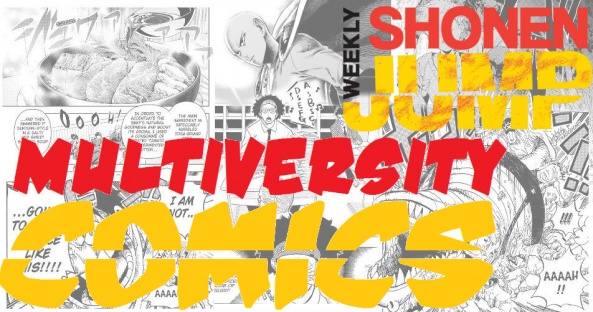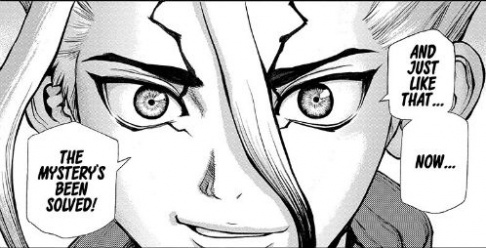
Welcome to This Week in Shonen Jump, in which a rotating duo of Multiversity staffers take a look at two stories contained in each installment of Viz Media’s Weekly Shonen Jump. For the uninitiated, Weekly Shonen Jump is an anthology that delivers more than 200 pages of manga of all varieties. We hope that you’ll join us in exploring the world of Weekly Shonen Jump each week. If you are unfamiliar, you can read sample chapters and subscribe at Viz.com.

This week, Darcy returns and editor Brian jumps in to check in with “Dr. Stone” and “Bozebeats.” If you have any thoughts on these titles, or “Black Clover,” “The Promised Neverland,” “Food Wars,” “We Never Learn,” “Robot X Laserbeam,” “One Piece,” or “My Hero Academia,” let us know in the comments!

Bozebeats Chapter 1
Written and Illustrated by Ryoji Hirano
Reviewed by Brian Salvatore
“Bozebeats,” in its first chapter, mixes up a ton of religious and spiritual iconography and mythology and tries to craft something new out of it. While it is hard to judge the overall success of the concept this early on, there is some fun stuff to be found in this chapter. There’s also a giant gun that shoots prayer beads, and I can’t imagine that being a bad thing for a comic.
The story centers on two characters: Tamaki, a boy with a wiped memory who has been raised by a wolf, and Ryudaiji, a priest who is trying to recruit Tamaki to his organization. That’s obviously simplifying things quite a bit, but there are a lot of details that seem a bit extraneous. The chapter spends a lot of time establishing Tamaki’s world, but we get a pretty good sense of it just a few pages in. Hirano seems to think that the reader needs specific and detailed discussion of the his origin, whereas it is plain to see from the beginning.
Ryudaiji is kept purposely vague; we know he is a Boze, and we see little hints of what his mission is. I understand why this is done from a storytelling perspective, but as a reader, I wanted far less conversations with wolves and self reflection from Tamki, and more prayer bead firing vestments/guns from Ryudaiji.
Hirano’s art is detailed and clean, but can get a little hard to follow during the action sequences. The Kodama Tree Spirit creature is reminiscent of something from the Mignolaverse, specifically the “Abe Sapien” stuff drawn by the Fiumara brothers. Hirano’s cross-hatching definitely evokes the 90s and, mixed with the giant gun, a few pages felt downright early Image.
Final Verdict: 7.3 – After a little too much in the woods, I’m very interested to see where the story goes now that the principles are in Tokyo.

Dr. Stone – Chapter 42: Tale for the Ages
Written by Riichiro Inagaki
Illustrated by Boichi
Review by Darcy Forrester
This newest chapter of “Dr. Stone” is almost entirely built off of the revelation, disclosed in Chapter 41, of the name of the village and its’ clear tie to Senku’s own family name of Ishigami. While the chapter is still peppered with humour and striking reaction faces, which are both becoming true staples of the series; this material had a decidedly more informational tone, rooted in backstory. This of course made sense to do, given that Ruri is relaying the 100th of her 100 tales to those who currently stand inside the village chieftain’s tent, and yet I found the execution of this narrative to be fantastic.
While Boichi’s art continues to impress, which should be recognised to an even greater degree with the knowledge that he actually illustrates two weekly manga series at the same time, Inagaki’s ability to condense such pivotal character information and context into a single chapter, should not be understated. The pacing of the chapter, which as previously stated still finds time to incorporate the prominently goofy reaction faces and impressively dynamic character interactions, is simply a joy to behold.
Chapter 42 starts by answering a few key questions that have been bubbling under the surface, since the story shifted away from Taiju and toward Senku and the people of the Ishigami Village. The first being that while we know it to have been possible for people to have naturally awoken from their petrification (with Taiju and Senku), villages like Ishigami must have been founded by someone. The second being the apparently Japanese features of characters like Ruri and Kohaku, despite them growing up in a world where almost all of the Japanese population are apparently encased in stone. Yet these two loose threads are connected by a single entity, which is revealed in this chapter to be Senku’s father Byakuya.
Continued belowWhile we may have seen elements of Senku’s past before, these instances have very much revolved around his relationship with Taiju. And while his childhood relationship with Taiju was also seen in this chapter’s significant flashback, it was instead Senku’s relationship with both science and his father that was the primary focus. A fascinating detail of this though, that I am very much glad was included, was Senku’s inability to utilise science as a means of helping his father to directly overcome his inability to swim well.
Although the majority of this arc has seen Senku rely on his scientific prowess to both overcome obstacles and recruit allies from the village, it is made clear that in this flashback, his application of science actually falls short. While his electrode suit may have been well intentioned, we are shown Byakuya’s honest admission during his astronaut interview that the suit is not what teaches him to swim sufficiently. Senku was still involved in bringing this about though, as Byakuya states that it was his son’s drive to help him achieve his dream that pushed Byakuya to make sure it would definitely happen anyway. The positive influence that Senku’s scientific curiosity and the wholehearted effort he invested into helping his father is beautifully depicted in this chapter, as prior to Byakuya actually achieving his dream of becoming an astronaut, his face is constantly obscured by shadow. Following his success though, and in the moments preceding his shuttle launch, his face is seen for the first time, and it is beaming for the cameras as he utters his son’s name proudly.
With the history of the village now revealed for all the characters present, I am very much interested to see where Inagaki takes the story of “Dr. Stone” from here. While the art in this series has always been top drawer, as you’d fully expect from someone of Boichi’s talents, the series’ narrative has certainly improved since Senku has been thrust into the foreground. But with him now being accepted by the village, and the mysteries of the village itself being revealed, I’ll be intrigued to see if we’ll stick with Senku for the foreseeable future, or instead return to the exploits of Taiju, Yuzuriha and Tsukasa. I very much hope for the former, but am fully aware that the latter three will have to return at some point.
Final Verdict: 9.2 – Chapter 42 is a near-perfect example of how to depict a succinct and effective backstory, while maintaining the humour and outrageous art that is increasingly synonymous with the series.






